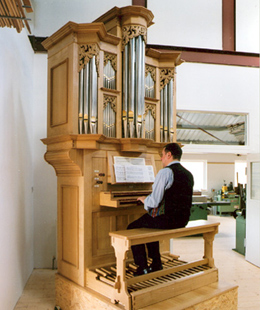


John Kitchen, writing in 2015, about his house organ, Opus 44:
I had much enjoyed having one of Neil Richerby's practice organs for some years, on loan from a friend. This was his Opus 11, consisting of two manuals, one with a Gedackt and the other with a Stopped Diapason, and pedal pull-downs. It was a very valuable practice organ which I used regularly for around 10 years; its light oak casework was very attractive (although with no pipes visible as all were of stopped wood) and its sound gently satisfying. But by that stage I hankered after an instrument of my own, and one which looked like a 'real organ'.
I did not have particularly firm views about what I wanted - I have extremely wide tastes in organ types, playing as I do a 1978 Ahrend one day and the Usher Hall's Norman and Beard the next! - but I did want an instrument which looked beautiful, with some sort of 'classic' pipe display. In discussion with Neil, and with the help of various images and drawings, we decided upon a Schnitger-inspired design. Basically, my organ looks like a Schnitger positive case, and is an object of considerable beauty.
Incidentally the light oak, after 10 years, has gently mellowed and darkened, and now has a satisfyingly rich, mature appearance. One small but interesting point is that Schnitger's organs generally omitted low C# and D#, but I required a full chromatic compass; Neil therefore has accommodated the two lowest pipes behind the central pipe display, starting the facade at 4' D to allow a coherent and visually pleasing layout.
This instrument was originally built to be accommodated in an Edinburgh flat, in a spacious but not enormous room with a high ceiling, and fitted it well, both visually and aurally. Subsequently it was moved to my present house, and into a larger room, where it looks and sounds even better.
I specified four stops on two manuals: two complementary 8' ranks and two at 4', one of which had to be a principal, and which would make up part of the facade. (The smaller pipes in the facade are dummies.) I did not want pitches above 4' which can be too shrill in a relatively confined space.
A 16' pedal Bourdon would have been nice, but would have taken up too much space in the flat. In its present location, there would have been room - just about - for such a rank, but this would spoil the organ's appearance. We could no doubt have accommodated somewhere a 16' reed with fraction-length resonators, but I do not find them particularly satisfying. Therefore, we decided simply to have pedal pull-downs to both manuals; there is also an inter-manual coupler. (While it does no harm, I have to say that I rarely use it.) After some discussion, we decided on a 58-note manual compass, and 30-note pedal compass. I was uncertain what kind of pedalboard to have, given that I wanted to play all sorts of music. I took Neil's advice here, and went for a concave/parallel board, which is a useful compromise.
Having now used this organ regularly for more than 10 years, playing all sorts of music on it, I can only repeat what I said in 2004: it is a beautiful musical instrument which encourages practice and fine music-making.
Specification
| Manual I: | Bourdon 8' | Oak and walnut |
| Principal 4' | 75% tin, in facade | |
| Manual II: | Chimney Flute 8' | Oak and walnut |
| Clear Flute 4' | Oak and walnut | |


